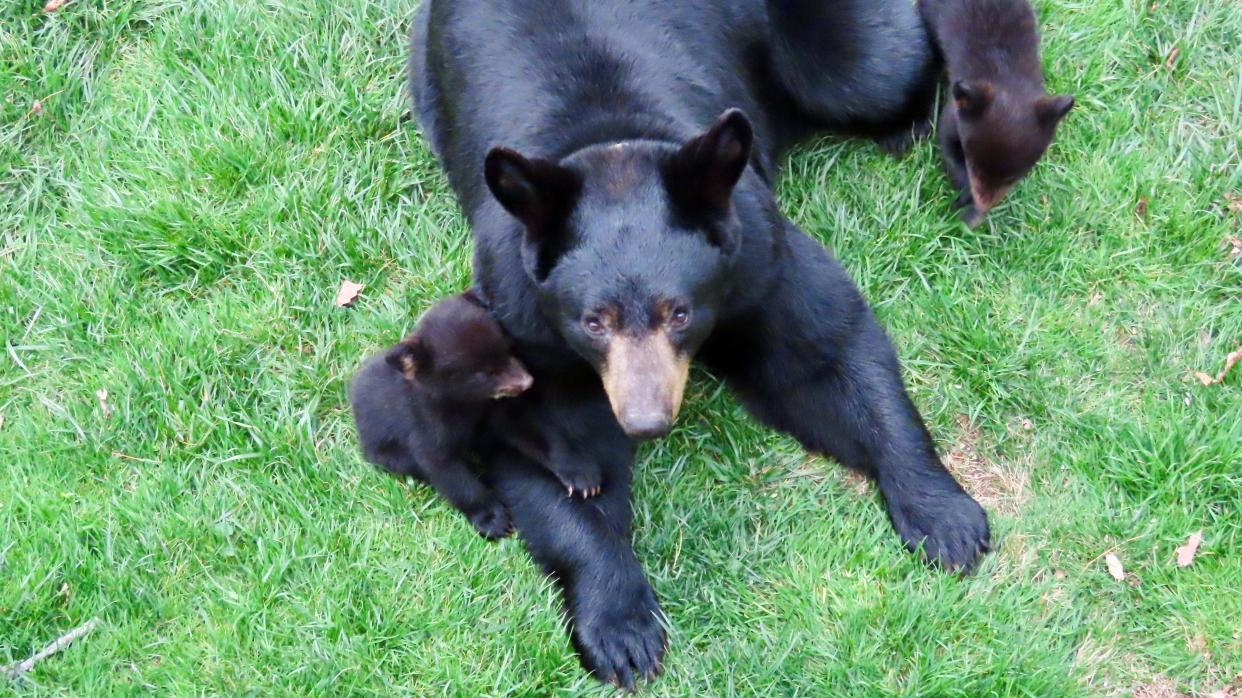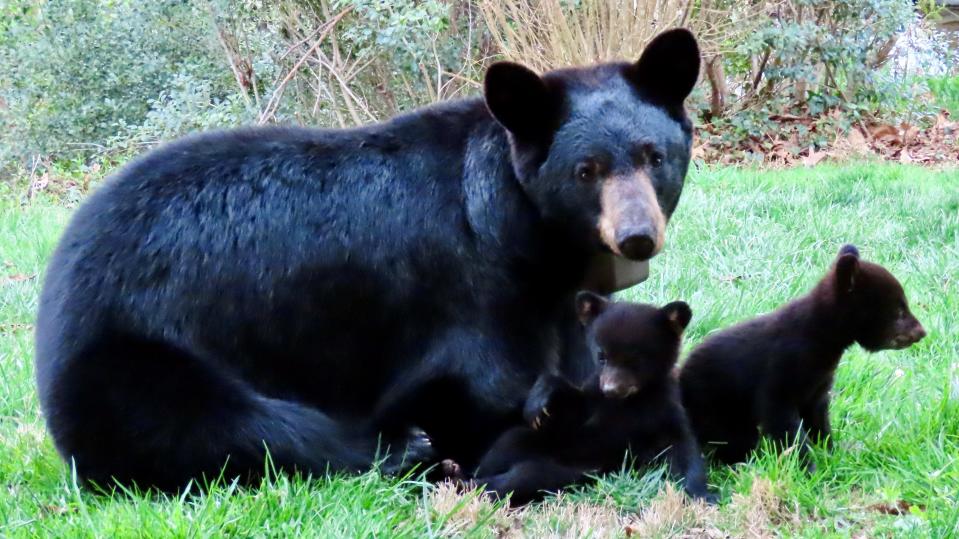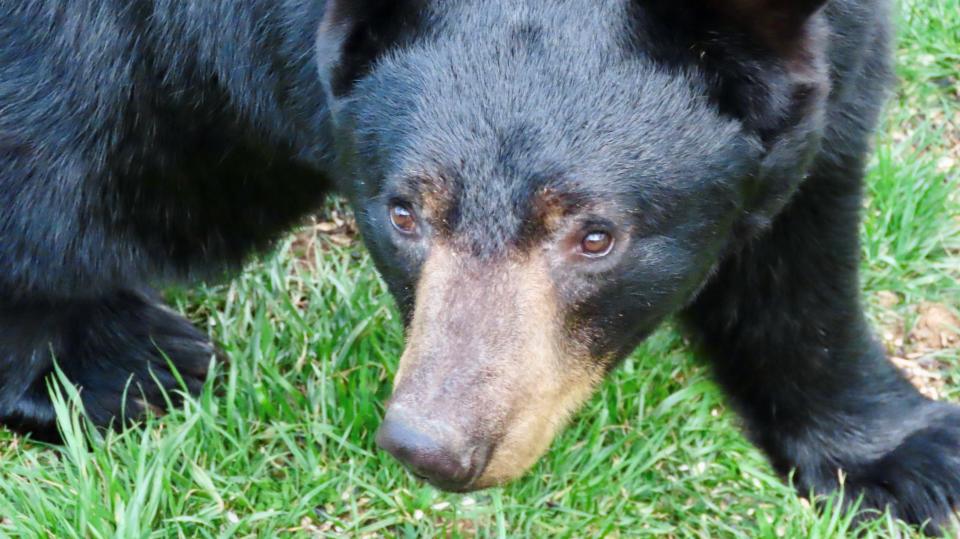What to know about black bears in Asheville in the spring

ASHEVILLE - The birds are chirping, the flowers are blooming, and the temperature is rising. It’s springtime and nature is reawakening, including the black bear residents of Western North Carolina.
In the Asheville area, humans and black bears coexist, so it’s not uncommon for there to be more bear activity in residential areas.
Black bears are less active in the colder, winter months, when they enter a torpor phase ― or a “false hibernation” ― wherein the bears’ metabolism and activity decrease, said Ashley Hobbs, special projects biologist for the N.C. Wildlife Resources Commission.
Now that spring has sprung, residents and tourists can expect to see more bears moseying along in and out of the city.
“Usually, by this time of year in April is when we see almost all the bears up and running again, so to speak,” Hobbs said. “They’ll be back to sort of their normal activity more and more as we have consistently nice weather.”
Hobbs provided insight into what the bears are up to this season, and the best practices for a safe and harmonious cohabitation.
More: Bears in downtown Asheville aren't going anywhere; here's what to do if you see one
More: Answer Woman: Is climate change keeping Asheville black bears awake during hibernation?
Baby bear season
Black bears’ reproductive cycle begins with breeding in early to mid-June, with the pregnancy developing around October or November when the mama bear’s body has the good condition to support the cub(s), Hobbs said.
Mama bear dens around November or December and gives birth in early January-February.

By April, the family of bears emerge from the den when the cubs are big and strong enough to follow her.
At birth, cubs are the size of a stick of butter, on average, she said.
On average, adult females are smaller and grow to weigh about 150-175 pounds. On average, adult males grow to weigh about 200-250 pounds.
Seasonal eats
Bears’ sizes depend on where they live, Hobbs said.
Urban bears living in more developed areas have more available food and may grow larger than rural living bears, she said.
“You’ll see them targeting more human-provided resources this time of year as well just because there isn’t a ton available to them naturally yet,” she said. “Things are starting to green out, leaf out, so they may be targeting roots and shoots, then they’ll switch over to insect larvae if they can find it, as well, but certainly trash cans, bird feeders and things like that are easy targets. We do see more activity around developed areas this time of year.”
Humans can do their part to reduce food accessibility and attractants in the city, which will help keep bears at a safe distance.
Food attractants
Attractants, like food, can draw bears to a home, vehicle or other populated areas.
Food attractants include bird feeders, garbage receptacles, pet food dishes, barbecue grills and other unattended food.
“It’s best when bears are active to avoid all of those attractants. In the case of bird feeders, the best practice is to not use bird feeders and to opt for more natural options like pollinator gardens – it’s better for bears and birds, everyone benefits when we don’t use bird feeders,” Hobbs said.
Those who prefer bird feeders are advised to use them seasonally when bears are less active.
“Bring your bird feeder in. Usually, Easter is a pretty good reference point,” Hobbs said. “Bring it inside and leave it inside until at least the Thanksgiving time of the year so we don’t have that attractant hanging off the back porch or in the backyard or front yard attracting bears.”
“One misconception is that you can bring your bird feeder in at night and I think if we took a quick poll around Asheville you’d find that most everyone has seen a bear in the middle of the day so that’s not necessarily an effective option where we live,” she said.
It’s a good practice not to leave food in a vehicle, too.
“We’ve had bears break into vehicles for something as small as a pack of gum,” Hobbs said.
Also, lock the vehicle’s doors, keep the windows up and close the sunroof ― and clean the stray French fries from under the seats. Bears can learn how to use classic door handles on vehicles and homes, so keeping them locked will deter them.
“A lot of times people will feel safe to leave their vehicle unsecured because they trust their neighbors and that’s fine, but I always tell them, ‘Don’t trust the bears,’” Hobbs said. “Just lock your doors, roll up the windows and try to keep food and crumbs out of it as much as possible.”
Breaking bad bear habits
A bear may not have been a person’s trash or yard yet but it’s best to take preventive measures before it happens.
Secure dumpsters, trash cans and bird feeders and other food sources so issues don’t arise.

“You should be proactive. Once you do have a bear accessing your resources, I tell people it’s kind of like those movies with the warehouse countdown: ‘We’ve had five days since our last accident.’ It’s sort of the same thing with bears,” Hobbs said. “Once they do get into, say your dumpster at your apartment complex, it’s very likely they’re going to come back if they are rewarded by that garbage again. Then, they’re going to come back again and they’ll set up this routine of constantly coming to the dumpster to access food. Once they start that habit it’s very hard to break that habit.”
Dumpster locks and reinforced trash can lids are available. They may require a bit more work but are worth it to avoid a lot of trouble in the future, she said.
When to call for assistance
In most cases, a bear sighting doesn’t require action.
“If you live in Asheville, you live in Bear Country so there’s no reason to call just because you see a bear,” Hobbs said. “For some people that’s a supernatural occurrence. They see multiple bears every day. Other people, maybe they see them once or twice a week or every few months. If you see a bear, that’s OK.”
But it’s best to know when and who to call for assistance if needed. The NC Wildlife Resources Commission biologists are there to assess a situation and determine if further steps are necessary.
“Bears should just be moving through your community and not sticking around so there’s no reason to alert us,” Hobbs said. “But if you did have something where a bear was approaching people or it’s lost its fear of people and is, for example, coming up on the porch and trying to get into doors, things of that nature, then you should definitely give the Wildlife Commission a call.”
Never approach or attempt to pet a bear, even if it’s an adorable cub that is suspected to have been orphaned.
“It’s not uncommon for moms to leave them in what she considers a safe space then she’ll go forage for a bit and come back maybe an hour or two later. That’s not uncommon and in most cases that’s what’s going on,” Hobbs said. “If you do suspect a cub was truly orphaned, give it some space, give a little time for mama to come back. You can monitor from a distance. If after 24 hours that cub is still there and you haven’t seen mom come back, then you can give us a call.”
In addition to the danger factor, picking up a cub or moving it may cause the mama bear to leave it in the long run, Hobbs said.
Call the Wildlife Commission helpline at 866-318-2401 or contact local authorities for assistance. Leave a message and a biologist will return the call within a business day.
The helpline may be used to request assistance for bears or any other wildlife.
Close bear encounters
Hobbs offered a few tips to follow in the case of crossing paths with a black bear.
Stop, back up and go in the opposite direction.
“You never want to run. Bears are omnivores so they still have that predatory chase instinct, and you don’t want to change an otherwise benign situation to a chase situation,” she said. “Just back up slowly in the opposite direction, give that bear a lot of space. Usually, bears want to get away from us as much as we want to get away from them.”
Give the bear an escape route so it doesn’t feel cornered.
In the rare case that a black bear does pursue, the person should try to make their body look as big as possible and “let them know they mean business,” she said.
More: Live black bear (not the mascot) spotted by Asheville Tourists staff in McCormick Field
The next step would be to throw rocks or sticks at the bear so it will “turn tail and run away.”
Dusk and dawn hours make it more difficult to see black bears, as they can blend in in the low lighting, she said.
Pets should always be on a leash when outdoors, so they are easier to control to de-escalate a potentially confrontational situation.
“Check your backyard before you take your dog out. Take your dog out on a lease each time just to be on the safe side,” she said.
For more safety tips and best practices resources, visit bearwise.org.
Tiana Kennell is the food and dining reporter for the Asheville Citizen Times, part of the USA Today Network. Email her at tkennell@citizentimes.com or follow her on Twitter/Instagram @PrincessOfPage. Please support this type of journalism with a subscription to the Citizen Times.
This article originally appeared on Asheville Citizen Times: What to know about black bears in Asheville in the spring

